Albany City Hall
Albany City Hall | |
U.S. National Register of Historic Places | |
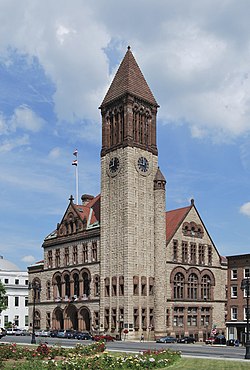 | |
| Location | Albany, New York |
|---|---|
| Coordinates | 42°39′06″N 73°45′16″W / 42.65167°N 73.75444°WCoordinates: 42°39′06″N 73°45′16″W / 42.65167°N 73.75444°W |
| Built | 1880–1883 |
| Architect | Henry Hobson Richardson |
| Architectural style | Richardson Romanesque |
| NRHP reference No. | 72000812 |
| Added to NRHP | September 4, 1972[1] |
Albany City Hall is the seat of government of the city of Albany, New York. It houses the office of the mayor, the Common Council chamber, the city and traffic courts, as well as other city services. The present building was designed by Henry Hobson Richardson in the Romanesque style and opened in 1883 at 24 Eagle Street between Corning Place (then Maiden Lane) and Pine Street. It is a rectangular, three-and-a-half-story building with a 202-foot (62 m) tall tower at its southwest corner. The tower contains one of the few municipal carillons in the country. Albany's carillon was dedicated in 1927 through the donations of 25,000 people. It has 49 bells ranging from small to gargantuan. The carillon's largest bell has a 5'9" diameter and weighs 10,953 pounds and the smallest bell weighs in at only 27 pounds.
Albany's first city hall was the Stadt Huys, built by the Dutch at the intersection of Broadway and Hudson Avenue probably in the 1660s, though possibly earlier. It was probably replaced around 1740 with a larger building, which continued to be known by the same name. In 1754, the Stadt Huys was the site of the Albany Congress, where Benjamin Franklin presented the Albany Plan of Union, the first proposal to unite the British American colonies. In 1797 Albany was declared the state capital of New York and the New York Legislature made its home in Albany's city hall. In 1809 the Legislature opened the first New York State Capitol and Albany's government moved in with the Legislature. After purchasing a plot of land at the eastern terminus of Washington Avenue, across Eagle Street from the capitol, the city government moved into a new city hall designed by Philip Hooker in 1829 and opened in 1832.
In 1880, Hooker's city hall was destroyed by fire and a new design was commissioned from Henry Hobson Richardson. The cornerstone was laid by Masonic fraternity on October 13, 1881 and the building was completed and opened in 1883. Because of budget restrictions the original interior was of simple design, consisting chiefly of beaded board partitions, and thus not fireproof. The building's interior was entirely rebuilt in 1916-18 from designs by Albany architects Ogden & Gander. The city hall remains essentially as altered at that time, and the exterior is considered one of Richardson's finest works. The building was added to the National Register of Historic Places on September 4, 1972.
Former city halls[]
Albany has had multiple buildings dedicated to being the seat of city government over its history. However, historians disagree on details of many of the earlier structures, namely, when they were built.
Stadt Huys[]
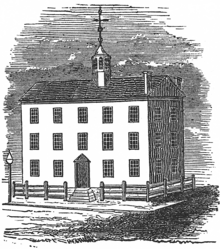
Albany's original city hall, the Stadt Huys (/ˈstæt ˈhaɪs/; Dutch for "city hall"; sometimes written Stadt Huis) may have been built as early as 1635. Evidence from the journals of Wouter van Twiller, Director of New Netherland (1633–1638),[2] suggests that at least some type of punitory building was built on the site during his term in office. George Howell and Jonathan Tenney, in their book Bi-centennial History of Albany, claim that reports from 1646 state the building was a substantial (at least for its time) three-story structure, with the lower floor built of stone and used as a jail.[3] However Albany historian Cuyler Reynolds claims the Stadt Huys was not built until 1673.[4] All sources agree that it stood at the northeast corner of today's Hudson Avenue and Broadway, the current site of the SUNY System Administration Building.[5] The Stadt Huys officially became city hall when the Dongan Charter incorporated Albany into a city in 1686.[6] An engraving of a 1695 map of Albany clearly identifies the Stadt Huys at the northeast corner of present-day Hudson Ave and Broadway.[7]
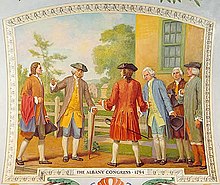
It is probable that a new city hall was built on the site of the Stadt Huys around 1740;[4] historians at the New York State Museum (NYSM) claim it to have been completed in 1741.[6] Growing tired of increasingly cramped space, the city government was able to secure funds from the provincial government to construct a new city hall on the same site.[6] This building was also commonly known as the Stadt Huys, even though it was a completely new structure and the English had been in control of New York for more than 75 years. The NYSM describes the new Stadt Huys as a three-story brick structure, adding that it was a "more substantial building" than its predecessor. This new building was the third-largest building in Albany, surpassed only by the local Dutch church (though not the one that stands today) and Fort Albany. The roof of the new structure was gabled and was topped with a cupola and belfry. Howell and Tenney claim that the original Stadt Huys was in use for at least 160 years (meaning a replacement structure would not have been needed until 1795 at the earliest), which is in disagreement with the idea that a new Stadt Huys was built in the 1740s.[3]
In 1754, the Stadt Huys was the site of the Albany Congress; Benjamin Franklin of Pennsylvania presented the Albany Plan of Union there. This was the first formal proposal to unite the British American colonies.[5] The Plan of Union's original intention was to unite the colonies in defense against aggressions of the French to the north; it was not an attempt to become independent from the auspices of the British crown.[8] Although it was never adopted by the British Parliament, it was an important precursor to the United States Constitution.[8] A month prior to the meeting, Franklin published his Join, or Die political cartoon, an infamous graphical representation of the Plan of Union.[9]
During the Revolutionary War, city hall was home to the Albany Committee of Correspondence (the political arm of the local revolutionary movement), which took over operation of Albany's government in 1775 and eventually expanded its power to control all of Albany County (which at that time was the largest county in the colony, extending far past its current borders).[10] Tories and prisoners of war were often jailed in city hall alongside common criminals.[11] Following the war, city hall was an occasional meeting place of the newly formed New York Legislature, in addition to being home to the city and county governments, the jail, courts, and local registry.[6]
In 1797 Albany was declared the official capital of the state and the Legislature made city hall its home until the first state capitol was opened in 1809.[12] In an effort to move public buildings away from the bustling and expanding waterfront, the new capitol was located atop the State Street hill, directly in front of the site where the current building now stands. City surveyor Simeon De Witt, in his 1794 plan of the city, indicates this land as being set aside as a public square; it had been dedicated for public purposes as early as the late 17th century. Also included on DeWitt's map are depictions of city hall and the new city jail, located at State and Eagle Streets.[13] In 1809, Albany city government moved with the Legislature into the new capitol and remained there until a new city hall was opened in 1832.[6] The old Stadt Huys was eventually demolished after a fire in 1836.[14]
1832 city hall[]

In an effort to move city and county government functions out of the state capitol building, the city purchased a plot of land to build on in 1832. They chose a site facing the public square opposite the capitol, on Eagle Street and at the eastern terminus of Lion Street (later renamed Washington Avenue); the land was purchased from St. Peter's Church for $10,295.95 ($267,000 in modern dollars).[15][16] The design of the new city hall was the result of a competition, that was won by Albany architect Philip Hooker and Boston architect John Kutts. Hooker was charged with integrating components of both architect's proposals into one coherent design. The cornerstone was laid by Mayor John Townsend in a Masonic ceremony on August 31, 1829. The building was completed in 1832 at a cost of about $92,000 ($2.39 million in modern dollars).[15] The design of the city hall combined neoclassical and Greek Revival detailing,[17] and was constructed of white marble quarried by inmates at Sing-Sing prison, with an entrance porch supported by six Ionic columns. A large belvedere supported a dome that was subsequently gilded. The principal rooms of the interior continued the monumental detailing of the exterior. A full-length statue of Alexander Hamilton by Robert Ball Hughes stood in the center of the upper hall, between the Court room and the Common Council Chamber. Upon one side of this hall was a bas-relief of DeWitt Clinton, with a view of a primitive canal-boat in the distance, and on the opposite wall was a similar figure of Sir Walter Scott.[16] Both of these panels were executed by William Coffee. The building was destroyed by fire on February 10, 1880.[18] Plans for a replacement city hall were quickly developed.
Current city hall[]

Following the 1880 fire, Henry Hobson Richardson, who was then active as one of a team of architects working on the nearby New York State capitol, secured the commission for the replacement city hall after a limited competition between six architects and architectural firms. The budget for the new city hall was limited to $185,000; Richardson's design came in at $184,000. However the appointed public committee upped the price to $204,000 after granite was substituted for brownstone in the design.[19] The new city hall design dates from the period that is typically regarded as Richardson's architectural peak.[17] His design was similar to others executed in his personal version of the Romanesque style. Architectural historian Henry-Russell Hitchcock described city hall as "one of Richardson's most Romanesque designs" and the building's NRHP nomination added: "Albany City Hall's banded arches, rhythmic fenestration, bold expression of materials and corner placement of the tower are characteristic features of Richardson's work often to be repeated by his followers."[20]
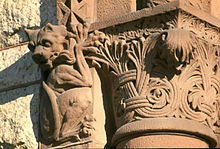
The building is a load-bearing masonry design laid out in a rectangle, with a 202-foot (62 m) tall, Venetian-style tower on its southwest corner topped with a pyramidal roof. The main structure is three-and-a-half stories tall and the front (west) face is nine bays wide.[21] The exterior walls are rusticated Milford (Rhode Island) granite with Longmeadow (Massachusetts) brownstone trim. Save for the bold asymmetrical placement of the tower (which is a prime example of Richardson's disregard for architectural correctness and known for being one of his best tower designs), the building is noted for its general simplicity in design. The entranceway is a simple triple-arch loggia; other design elements on the front façade are limited to its windows and a quadruple-arch balcony off the Common Council chamber. The building is simultaneously noted for its general simplicity and care for small details, especially its intricate carvings.[17] The entranceway is flanked by multiple tiers of relief sculpture and gargoyles.[22] Most of the stone cutters originally brought to Albany to work on the capitol were later hired to do the sculptural details on city hall.[20][23]
Many elements of the exterior design are representations of interior functionality. Because the Common Council chamber is located on the second floor (above the entrance), that story is the same height as the first-floor entrance hall. The tower is essentially window-less because it was meant to be the city archive; a round staircase extends up the southeast corner of the tower for access. The short tower on the building's southeast corner was originally meant to be the transition between city hall and the (to-be built) jail, complete with a "bridge of sighs" to transport inmates straight from their cells in the jail to the court rooms in city hall.[22]
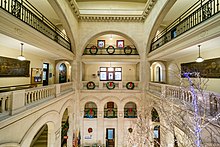
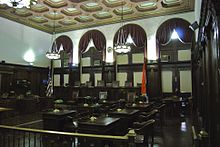
Due to lack of funds at the time (the building's initial budget doubled, ending up at $325,000 ($8.72 million in modern dollars[15]) including furnishings),[19] Richardson devoted most of his efforts to the building's exterior.[22] A report from the Times Union states, "There wasn't enough money for Richardson to do the job as thoroughly as he would have liked. He said in his writing that if there wasn't sufficient money, he'd rather do it right on the outside and leave it to a future generation to finish the interior. The interior was finished by city architects a good 30 years after Richardson built it."[23] The "city architects" were Ogden and Gander who designed the alterations in 1916 that were subsequently completed in 1918.[17] The mayor's office is on the first floor of the tower, the Council chamber and offices are on the building's second floor, and the city clerk's office is on the second floor of the tower. The mayor's office contains a painting of the city's first mayor, Pieter Schuyler.[17]
Under the leadership of William Gorham Rice in 1927, a carillon was added to the tower; it contained sixty bells (though it could produce only 47 different notes since top notes have double bells) made by John Taylor & Co in England. Financed by public donations (from upwards of 25,000 people), it cost $63,000 ($9.46 million in modern dollars[15]) and was the first municipal carillon in the United States.[17] In 1986 Mayor Thomas Whalen had the carillon restored, which included replacing 30 bells and adding two notes to its repertoire. The 49 bells weigh 27 short tons (24,000 kg). The largest bell is 5 feet 9 inches (1.75 m) in diameter and weighs 10,953 pounds (4,968 kg).[24] The carillon is still in use and is played during concerts several times a week.[25]
The clock faces on the tower were added in the 1920s, possibly around the time the carillon was added. The 1897 image of the city hall above shows the tower without the clock faces (although the stonework shows obvious intent to have clock faces installed).[26] City hall was added to the National Register of Historic Places on September 4, 1972.[1]
See also[]
- List of mayors of Albany, New York
- National Register of Historic Places listings in Albany, New York
- Statue of Philip Schuyler
References[]
Informational notes
Citations
- ^ a b Liebs (1972), p. 9
- ^ "Van Twiller, Wouter (1580–1646)". New Netherland Institute. Archived from the original on 2010-06-14. Retrieved 2010-08-15.
- ^ a b Howell, George Rogers (1886). Bi-centennial History of Albany: History of the County of Albany, N.Y., from 1609 to 1886. W. W. Munsell & Company. pp. 346–347.
- ^ a b Albany Chronicles: A History of the City Arranged Chronologically, from the Earliest Settlement to the Present Time. J. B. Lyon Company, printers. 1906. p. 249.
- ^ a b Rittner, Don (2002). Albany. Arcadia Publishing. p. 22. ISBN 978-0-7385-1142-9.
- ^ a b c d e "City Hall". New York State Museum. 2002-02-28. Retrieved 2010-08-17.
- ^ Map of Albany (Map). Unknown (engraving), John Miller (map). 1886.
- ^ a b McEneny (2006), p. 12
- ^ McMaster, John Bach (1896). Benjamin Franklin as a Man of Letters. Boston: Houghton, Mifflin and Company. p. 162. OCLC 2118072.
Franklin Join, or Die albany plan.
- ^ "Albany County". New York State Museum. Retrieved 2010-08-19.
- ^ Bielinski, Stefan (2010-03-08). "The Committee of Correspondence". New York State Museum. Retrieved 2010-08-19.
- ^ Stevens, John Austin (1886). The Magazine of American History with Notes and Queries. Historical Publication Co. p. 24.
- ^ A Plan of the City of Albany (Map). Cartography by Simeon De Witt. City of Albany. 1794.
- ^ Reynolds (1906), p. 516
- ^ a b c d "Federal Reserve Bank of Minneapolis Community Development Project". Federal Bank of Minneapolis. Archived from the original on 2018-04-07. Retrieved 2018-10-04.
- ^ a b Howell and Tenney (1886, Volume II), p. 677
- ^ a b c d e f g Waite (1993), pp. 70–71
- ^ Reynolds (1906), p. 687
- ^ a b Ochsner (1982), p. 235
- ^ a b Liebs (1972), p. 12
- ^ Leibs (1972), p. 2
- ^ a b c Liebs (1972), p. 11
- ^ a b Grondahl, Paul (1998-03-22). "'The Great Mogul' and His Legacy". Times Union (Albany). Hearst Newspapers. p. J4. Archived from the original on 2011-12-11. Retrieved 2010-08-22.
- ^ "History of the Albany Carillon". Friends of the Albany City Carillon. Archived from the original on 2008-08-27. Retrieved 2010-08-21.
- ^ "The Albany City Carillon". Friends of the Albany City Carillon. Archived from the original on 2011-07-24. Retrieved 2010-08-21.
- ^ Carleo-Evangelist, Jordan (2010-07-23). "Ticked Off No More". Times Union (Albany). Hearst Newspapers. p. D1. Archived from the original on 2011-08-11. Retrieved 2010-08-22.
Bibliography
- Howell, George Rogers; Jonathan Tenney (1886). Bi-centennial History of Albany: History of the County of Albany, N.Y. from 1609 to 1886 (Volume I). New York City: W. W. Munsell & Co. OCLC 11543538.(Full text via Google Books.)
- Howell, George Rogers; Jonathan Tenney (1886). Bi-centennial History of Albany: History of the County of Albany, N.Y. from 1609 to 1886 (Volume II). New York City: W. W. Munsell & Co. OCLC 11543538.(Full text via Google Books.)
- Liebs, Chester H.; Cornelia E. Brooke (1972-05-08). "National Register of Historic Places Inventory/Nomination: Albany City Hall". New York State Office of Parks, Recreation and Historic Preservation. Archived from the original on 2011-12-11. Retrieved 2010-08-15. Accompanying 2 photos (exterior) from 1970
- Ochsner, Jeffrey Karl (1982). H. H. Richardson: Complete Architectural Works. Cambridge, Massachusetts: The MIT Press. ISBN 0-262-15023-9.
- Reynolds, Cuyler (1906). Albany Chronicles: A History of the City Arranged Chronologically, From the Earliest Settlement to the Present Time. Albany: J. B. Lyon Company. OCLC 457804870.(Full text via Google Books.)
- Rittner, Don (2002). Then & Now: Albany. Charleston, South Carolina: Arcadia Publishing. ISBN 0-7385-1142-0.
- Waite, Diana S. (1993). Albany Architecture: A Guide to the City. Albany: Mount Ida Press. ISBN 0-9625368-1-4.
External links[]
| Wikimedia Commons has media related to Albany City Hall. |
- The Albany Carillon
- Albany City Hall Archived 2017-07-27 at the Wayback Machine, hosted by the government of the City of Albany
- Historic American Buildings Survey entry from 1981, hosted by the Library of Congress
- Government buildings completed in 1741
- Government buildings completed in 1883
- Towers completed in 1883
- Bell towers in the United States
- Buildings and structures in Albany, New York
- Clock towers in New York (state)
- Former state capitols in the United States
- City and town halls on the National Register of Historic Places in New York (state)
- Henry Hobson Richardson buildings
- Richardsonian Romanesque architecture in New York (state)
- Tourist attractions in Albany, New York
- National Register of Historic Places in Albany, New York
- Individually listed contributing properties to historic districts on the National Register in New York (state)
- Skyscrapers in Albany, New York



